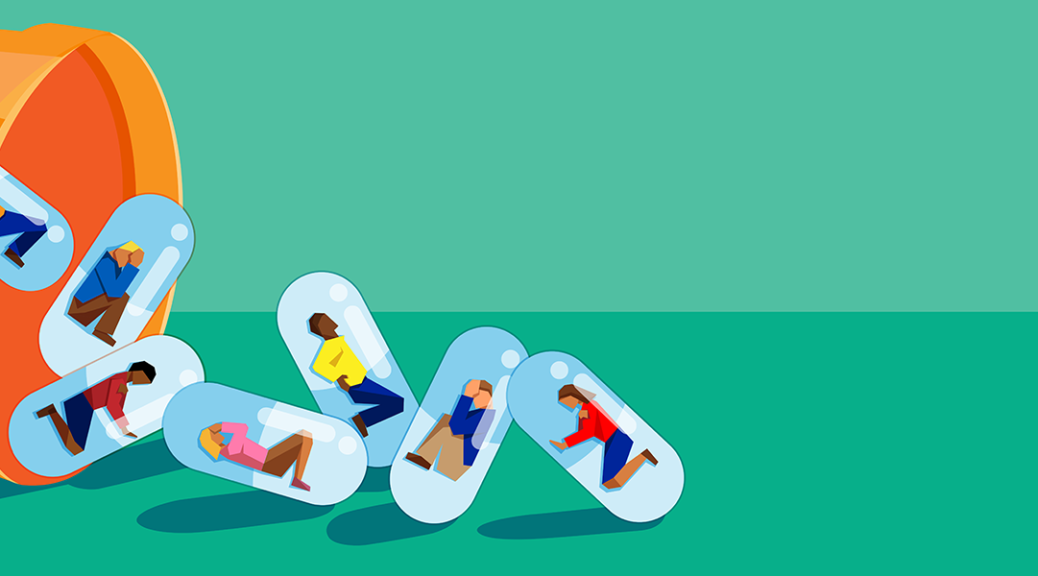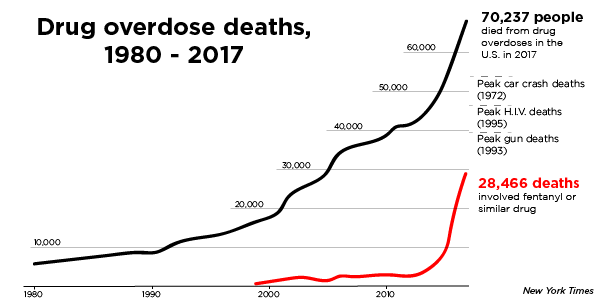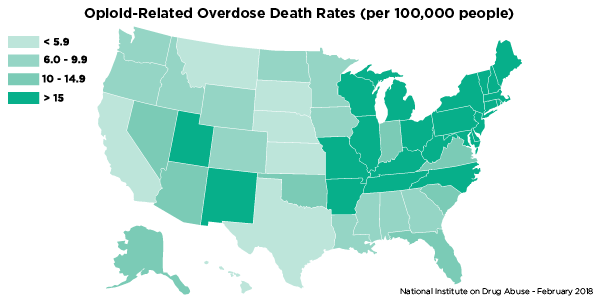Fighting the Opioid Crisis

The opioid epidemic is dominating national news stories as it lethally sweeps through local communities. Drug overdoses killed over 70,000 Americans in 2017 with the vast majority involving opioids. This public health emergency continues as an average of 130 people die each day from opioid-related overdoses. The opioid crisis is driven by the widespread misuse of prescription pain-relieving medications and non-prescribed opioid.
What is an opioid?
A category of highly addictive drugs, opioids affect the brain receptors in the nervous system which regulate pain throughout the body through the central and peripheral nervous system. Opiates derive from a type of poppy plant that contributes natural chemicals in the manufacturing of morphine, heroin, Vicodin, Percocet, and OxyContin.
What is the opioid crisis?
Pharmaceutical companies’ aggressive marketing of pain medications in the 1990s included the false claim that opioid use by patients in pain could not lead to addiction. Subsequent over-prescribing by physicians played a major role in generating the first wave of the epidemic. With the federal, state, and local law enforcement’s crackdown on so-called “pill mills,” and the prosecution of implicated medical professionals, addicted patients were eventually cut off from access to prescriptions opioid medications. This gave rise to the second wave of the opioid epidemic that came in 2010 with increased heroin use, and a third wave that began in 2013 with the increased use of especially dangerous synthetic opioids like fentanyl.
Drug overdoses are now the leading cause of death among Americans under 50 years old. Opioid Use Disorder profoundly impacts the lives of the affected individuals, families, and the communities in which they live. According to the Substance Abuse and Mental Health Services Administration (SAMHSA), there are over two million Americans who have significant problems with opioid abuse and addiction.

Croney
“From my earliest years as a clinician, I worked with persons and families struggling with addiction,” said Elizabeth Croney, MSW, LCSW, Executive Vice President for Clinical Advancement at KVC Health Systems. “There was usually a great sense of hope because these disorders were very treatable if clients had access to services and became committed to the long journey of a recovery lifestyle. The climate now is quite different because addiction—while always a social problem—has now become a public health emergency.”
Who is affected by the opioid crisis?
The impacts of the opioid epidemic are devastating. People of every racial demographic are impacted by overdose deaths, and nearly every age has been touched by opioids. The crisis is across the U.S. with the highest overdose rates occurring in West Virginia, New Hampshire, Kentucky, Ohio, and Rhode Island.
The number of children and teens in foster care has risen because of parental drug use. In the worst cases, parents have died and left their children orphaned; affected extended family networks are often unable to care for these children, resulting in the state taking custody. Even in non-lethal cases, addicted parents and relatives become increasingly unable to care for their children. For example, in West Virginia, parental Opioid Use Disorder is the chief cause of the 24% increase in children in foster care between 2012 and 2016. The traumatic loss of parents through addiction-related death and disability certainly derails healthy childhood brain development, which relies on stable relationships and the fulfillment of basic human needs.
How can we fight the opioid crisis?
Communities and the government are working to increase prescription drug monitoring programs that will set standards for doctors when they are prescribing opioids as medication. In 2017, President Trump declared a national Public Health Emergency and directed agencies to help improve the situation with grants, investigations and treatment facilities.
The U.S. Department of Health and Human Services has released a 5-point strategy that includes
- More effective prevention, treatment and recovery services
- Accurate epidemiological data on the epidemic
- Effective low-dose opioid and non-opioid pain management
- Enhanced distribution and use of overdose-reversing drugs
- Increased funding for research on pain disorders and addiction prevention
In October 2018, a new bipartisan bill was signed into law called the SUPPORT for Patients and Communities Act. This bill aims to address the opioid crisis by encouraging the development of innovative prevention and treatment approaches with individuals and families. Such approaches also include helping children who have been impacted by trauma by requiring schools to become trauma-informed and by offering grants to schools for trauma support services.
“KVC is already working hard to respond,” said Croney. “For many years, KVC has created a culture of using evidence-informed and evidence-based approaches that allow its professionals to respond to complex issues facing families and children. At the outset of this new challenge, many KVC professionals have added effective addiction treatments to their armamentarium of approaches.”
KVC is currently using a trauma-informed approach model and completed the first-ever study of using a trauma-informed model for foster care that has produced incredible outcomes. Read more about the study here. In some areas, KVC has integrated evidence-based approaches to addiction disorders with its in-home, community-based, wrap-around, family-based treatment approaches. This is one extremely powerful strategy for fighting the opioid epidemic.
How you can help
The opioid epidemic is an extremely complex public health emergency and even experts know that drastically reducing the prevalence of Opioid Use Disorder will require concerted and coordinated efforts including more funding, regulation, and education. There are things that you can do right now to help those who have been affected.
- Become a foster parent to a child who is in care. Open your heart and provide a stable, loving home for a child whose parent is working to overcome their challenges.
- Advocate for programs and policies that promote drug education, appropriate prescriptions, and prevention/treatment/recovery solutions.
Related Articles
- How the Opioid Epidemic is Literally Changing Kids’ Brains
- Foster Care in America: Realities, Challenges and Solutions
- Healing From the Life-Long Effects of Childhood Trauma [VIDEO]
- Addiction is Not A Moral Failure… It’s a Brain Disorder [TED Talk]







